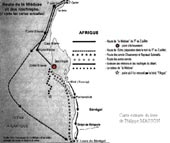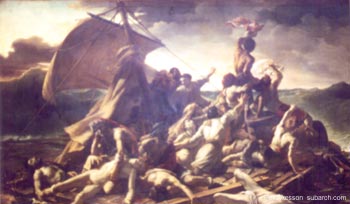|
According to the Paris peace treaty of 1814, England returned the colony of Senegal to France. The French Navy equipped the frigate La Méduse and three more ships. In 1816 they left to regain control. La Méduse carried 395 people, civilian and military. For some reason La Méduse left its nearest accompanying ship, L'Echo, trying to follow a sneak route closer to the coast. Of course she navigated too close to the African coast, and on 2 July she struck a sand bank off Mauretania. solid black: Méduse route, solid dots: raft route The ship was stuck, L'Echo was out of sight and the two other ships were far behind. The ship had to be abandoned. The three ship boats could only take about 250 people, so a raft was constructed for the remaining. 17 people decide to stay on the ship, while the rest enter boats and raft. The raftThe raft is made from mast and rigging on La Méduse. It's 20x10 metres, loaded with 130-150 people it's heavily overloaded. When the boats can't tug it as intended, it drifts out of sight. After five days the boats arrive at St Louis in Senegal and a rescue team is sent for the raft and the ship. Meanwhile life on the raft turned ugly – desperate fight for remaining water, soldiers killing civilians, and cannibalism. When the raft was found after 14 days adrift, 15 were still alive. Five of those die soon after, thus 10 survived. Among the survivors was the surgeon Savigny, whose report was to rouse a scandal. The rescue party also returned to the ship, that was still standing on the sand bank. But without any drinking water, so only five out of the 17 had survived on the ship. And those five were totally insane. On the following trials in 1817, Captain Chaumareys of La Méduse got 3 years in prison for incompetence. photo by Per Åkesson The paintingA famous painting of the horror scene, painted by Théodore Géricault in 1819, is displayed at the Louvre. To get the grim image right the painter studied corpses at the morgue. Unfortunately, due to the chemicals in the paint, the painting slowly turns darker and darker. A restoration will be very difficult, so you may want to visit Paris while it's still visible. DiscoveryMuch later, French archaeologist Jean-Yves Blot received information about La Méduse from Professor Theodore Monod. Blot started the investigations, using a magnetometer developed by the physicist Anatol Abragham. The Blot team had 25 square kilometres to search. To navigate the search pattern, an early French satellite navigation system was used. In 1980 they struck lucky and the instruments worked very well – the wreck was located from a distance of 120 m. The site was investigated. About 100 objects were recovered, among those a bronze swivel-gun. All artefacts, which proved the identity of the site, were delivered to the Mauritanian Institute of Scientific Research in Nouakchott, capital of the country. Per Åkesson, June 2002 BibliographyJean-Yves Blot: La Méduse, Chronique d'un naufrage (Arthaud 1982). Jean-Yves Blot: Underwater Archaeology: Exploring the World Beneath the Sea (Thames & Hudson/Abrams 1996) Sophie Gillet: Le radeau de la Méduse Philippe Masson: L'affaire de la Méduse, le naufrage et le procès, coll. Documents d'histoire (Tallandier, Paris 2000) |


 Back to Nordic Underwater Archaeology
Back to Nordic Underwater Archaeology